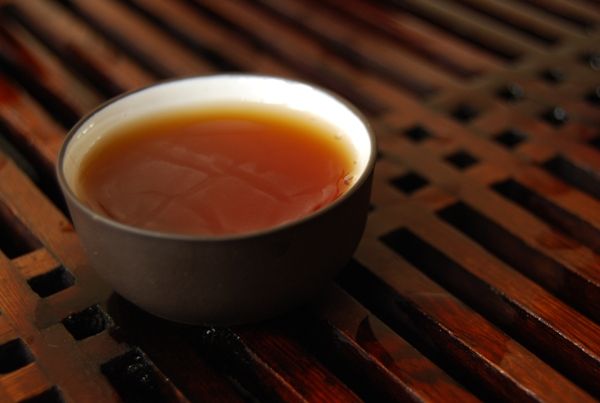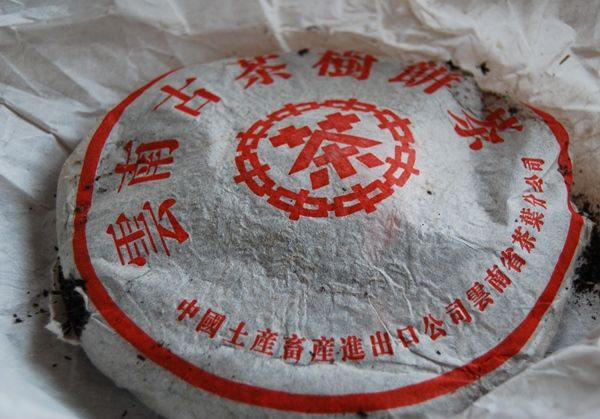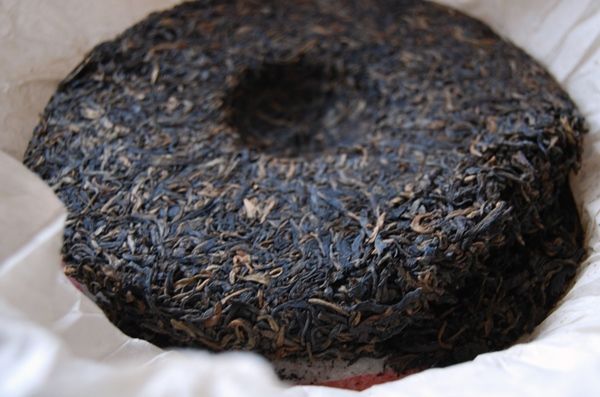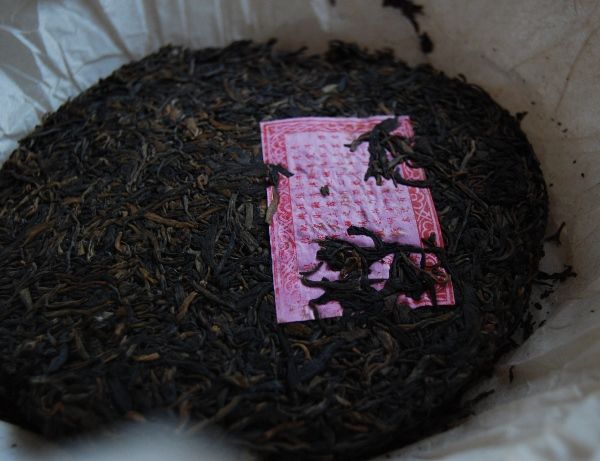Image swiped from the vendor page, as I don't have the cake itself
What if...
What if these lovely, potent news teas that we're carefully buying and storing don't turn out to be entirely awful?
What if their potency and longevity transforms into a similar potency and longevity in some aged sense?
What if everything just works out well, and we're left with beautiful tea?
That would be quite something.
Yum
Some old teas are short-lived. They're old, but not complex. They have limits. Meanwhile, some old cakes are big and beautiful, packed full of stuff. They have a lot to say.
How do we pick the latter from the former?
The received wisdom is that "nobody knows". Up to a point, that is true. We don't have twenty-year-old versions of our single-mountain cakes, by and large, against which to compare our tea.
However, we do have cakes that are aging nicely. We can see what has happened to our (i) orange, processed, constrained, drink-it-now teas, and (ii) our yellow, long-lasting, potent, kuwei teas. We probably have good numbers of both categories, or have at least tried them, over the course of five years or more of personal observation. That's not very long in the grand scheme of a tea's life, but it is long enough to observe changes.
We can then compare those changes with similar-tasting older cakes, in order to try and get a loose understanding of the bigger picture. Some artful, undoubtedly error-prone and highly approximate, combination of extrapolation and interpolation allows us some insight into what ages well. We're no longer quite as ignorant as once we were.
The cakes that are turning out to age the most pleasantly on my shelves are those of type (ii) in the above. They have a lot of backbone, a lot of character on which the effect of the years can act. Conversely, my cakes of type (i), while improving and becoming woody, are short-lived. They don't brew as many infusions as their potent, untreated brethren, and they don't develop quite the same power in the throat, either. The difference is marked, and obvious. So yes, while approximate, there is a definite difference. While they are all becoming darker and redder with age, they are not converging in potency - that gap remains as much as when they started out.
Hence, I don't quite buy the "there are no ways to determine how well our tea will do" line any more. Empirical observation, partial and unreliable as it is, does have something to say on the matter. It is not expertise, to be sure, but it is no longer blank, information-free ignorance.
Sweet and woody
This Henglichang* cake is an excellent example of an aged cake that has real "trousers". The leaves are homogenous in colour - there is no partial blend of type (i) leaves. The whole tea is a big, mahogany treat. It is a big, bold tea that is doing very well for its years. I appreciate its power, its duration, and its complexity.
Will all our tea end up this way? Well... that's back to the series of "what if?" questions, above. I'd recommend trying a sample of this tea just for the sake of education alone.
The cake appears to have sold out long ago, for which my wallet thanks me.
*Thanks to LP for correcting the pinyin from "Henlichang"
*Thanks to LP for correcting the pinyin from "Henlichang"
Addendum
March, 2011
I notice with some amusement that I previously wrote, "The cake appears to be sold out, for which my wallet thanks me."
Happily for me, less happily for my wallet, Essence of Tea has restocked this cake. The wrapper is loose, which lends it the characteristic feeling of a louche old gentleman, leering toothlessly at you.
The image is further reinforced as the radial warping of the cake makes it feel as if that particular gentleman is propped up against a bar-stool, or reclining on a chaise longue. In a patched, slightly worn smoking jacket.
It is a charming cake, as described previously. Heartily recommended.







18 comments:
unfortunately (or perhaps fortunately) Nada has updated his site with more of these...
When I tried this a month or so ago I got so excited that I quickly snatched up the last cake, and sent Nada constant emails pleading to get more of this...and I will have *at least* two cakes of this in my possession
anyway, my strongest impression of this tea was its unbridled bitterness, which I've never experienced before in a tea this age. I can see this little number providing a "back bone" to sweetly aged Yi Wu cakes.
Dear Maitre_Tea,
Thanks for the note; this article was written a week or so ago, as you have noticed!
I didn't get tons of bitterness, but perhaps I'm becoming too accustomed to taming wild young teas via short brews. It is bitter, but perhaps not quite the bitterness of Nada's Bulang from 2009, or the forthcoming cake from this year. Both are really very powerful, but combined with excellent quality and a very engaging mixture of characteristics. If those more recent cakes turn into something like this 1997 Henlichang, we'll all be "sitting pretty"...
Toodlepip,
Hobbes
Regarding your reference to "orange, processed, constrained, drink-it-now teas", have you any ideas how such teas are "processed"?
Are we talking about a process during production or after production for eg? what do "they" do to young sheng to make it more "drink now"?
And I agree - that Bulang is super tea.
So many questions!
I'm sure there are much more qualified observers of the production practices of Yunnan producers than me, but such "neutering" could be achieved by allowing the leaves to oxidise to varying degrees prior to shaqing, or by cooking longer, or, some say, applying a roaster afterwards rather than allowing the results to sun-dry. I suspect the former is the most common practice - you tend to see a portion of the blend "reddened" in such a manner, in mainstream cakes. This could be accidental (damage or allowing time to lapse) or intentional.
I'd encourage you to try tons of cakes and draw your own conclusions rather than accept mine. :)
Toodlepip,
Hobbes
The taste of this tea reminded me of maple syrup. By the fourth infusion I was overcome by the power of the tea. Time will mellow this cake nicely.
I'm going to have another crack at this and keep an eye out for maple syrup :)
Toodlepip,
Hobbes
To be a little more specific the bitterness definitely wasn't the bitterness of a young tea...it was more of a "hey, shouldn't 13 years of slightly wetter storage take care of this" sort of bitterness.
I've only encountered this sort of strength in a few very special teas, so I guess I should consider myself very lucky to have this one.
I believe the bitterness comes from the heavy amount of buds, which means I should be on the look-out for bud-heavy teas now!
Dear Maitre-Tea,
You raise a point that I have not heard before - bitterness and tips. For me, and this is just my own observation and limited to being exactly that, bitterness comes from the "basis" leaves. In my estimation, tips can provide a silkiness, some smooth texture (when young), but their effect on the character is to reduce the overall bitterness of the cake, because they are not bitter themselves.
I base this observation on tippy teas - they are gentle, "feminine", sweet, light. Taken to its extreme, the baihao / jinzhen / yinzhen cakes (mostly tips) are very grassy and light. They don't age well - they become lighter and lighter, ever more gentle, before fading into a sweet background.
Just my observations, but different to your own conclusions nonetheless. Take 'em for what you will!
Toodlepip,
Hobbes
(I suspect that the potency of this cake is due to its proper rawness, and its original Bulang power. There is, as I wrote in the article, cause for hope for our own teas!)
I'm not too certain, but I believe there's a difference between buds and silver tips. I bring up the bud-heaviness as a reason for the bitterness because:
a. I had asked Jason (BBB) this before and that's what he said, and
b. In the pre-order email Nada sent out he wrote of the Bu Lang, "The maocha isn't quite as bud-heavy this year though, which has resulted in a slightly reduced bitterness (ku wei) and increased depth of flavour."
I'm investigating what exactly the difference is between buds and silver tips.
Dear Maitre-Tea,
I imagine that the two gentlemen are referring to the bulbous, fat young leaves rather than the furry yinzhen tips as I initially thought you meant.
In terms of complexity, I rather like mixtures - plenty of bulbous younger basis leaves, plenty of heavier lower leaves, some stems, some huangpian... This Henglichang Bulang, for example, has all manner of leaves, which seem to have helped it.
Toodlepip,
Hobbes
... Did you hear that? It's the sound of my wallet cursing you ;) But I can't wait to try this one out. Thank you for the updated post.
I hope that you like it! I would feel particularly bad if you spent what is a very significant sum of money only to find it's not your cup of tea. I assume that you have tried a sample. :)
Toodlepip,
Hobbes
No, I'm afraid I broke the cardinal rule in this case, knowing that a blessing from Hobbes would mean this one would be gone very soon (and it was -- only samples left now). Had it been any other vendor I would have balked, but I've come to trust the quality of EoT's teas and have yet to find one of their offerings not to my liking.
Gosh, has it really? Well, I hope you'll enjoy it nonetheless!
I also find that Essence of Tea's range is trustworthy.
Toodlepip,
Hobbes
EOT has just restocked this tea (12/2011). After tasting a sample I ordered two bings. This is a prefect tea with the base of a young pu but with great hints at aging.
Good news! I bought a cake for my birthday, last year. It's one of my favourite gifts of all time.
Toodlepip,
Hobbes
Hello Hobbes,
I just finished my first session with this tea. What an interesting cake!
I think I might have oversteeped the first few infusions quite a bit, but I'll adjust it next time. :)
The wet leaves have an interesting scent of wet earth mixed with old dusty books; it's a strange but pleasant smell that gives me the sensation of opening an old chest filled with books, or maybe entering an abandoned and somewhat humid library that has been closed and abandoned for many years.
The liquor is a thick, dark red-brown liquid with that same old wet earth aroma. It has a complex, strong and slightly bitter flavour filled with earthy and woody notes, particularly in the aftertaste. It's easy to detect the humid flavour acquired during what seems like wet storage.
Having jumped from a 2011 directly to a 1997 cake, I found the wet storage flavour to be a bit overpowering, but it was still very enjoyable. I did oversteep the first few infusions, so that could have something to do with it.
This is one of those teas that takes some work to describe. The flavour is quite complex and contains quite a bit of history. :)
Post a Comment